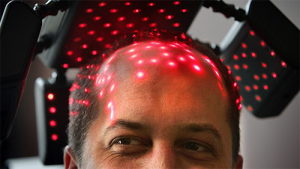
No one wants to lose their hair. It seems so insignificant, so small in the grand scheme of things, but hair loss can have a big emotional impact. For men, it heralds a sign of age to the public. “He’s starting to bald; he’s getting old.” Less frequent but perhaps even more emotionally debilitating is hair loss in women.
Dr. Jack Fisher of Nashville sees patients struggling with hair loss frequently in his plastic surgery office. “Hair loss has a significant impact on a person’s self-esteem and appearance,” he admits. The good news is treatments for hair loss are growing and are at a point today where patients are finding success. Dr. Fisher examines a few of those treatments, defining the options that can help restore hair and – even more importantly – self-esteem and confidence.
 Does laser stimulation work?
Does laser stimulation work?
The truth of the matter when it comes to hair-loss is the genetic coding of our hair follicles. For those who go bald in areas, their fates were predetermined; somewhere in their genes, a code tells hair follicles to turn off, never to be turned on again. Understanding this theory of science is where physicians begin hair-loss treatment. First things first: seeing if those follicles can be stimulated.
“There’s all kinds of factors that can contribute to either hair loss or hair thinning,” says Dr. Fisher. “Today, we have multiple options to thicken up the hair. The important thing is the follicle has to be there. You can’t just stimulate an area of skin and hope for hair to grow. There has to be a dormant, or sleeping follicle. What we can do with a laser is add increased blood flow to the scalp to try and stimulate the follicle. That being said, I always tell patients considering a laser treatment, there is no guarantee.”
While lasers have improved dramatically in recent years across all areas of aesthetic medicine, tried and true hair-loss treatments such as hair transplantation are still the go-to procedures.
Hair Transplantation
Restoring hair the traditional way involves transplanting follicles to regions where hair has stopped growing. The techniques and aspects of transplantation have evolved and been refined, but still center around removing patches of skin in the back of the scalp. Hair follicles are then divided and reinserted where hair is lacking.
“I still use in a lot of patients what is called the strip technique,” says Fisher. “You take a segment of scalp out from the back, sew it closed very carefully to minimize scarring, then I have my very skilled team cut the strip into small grafts, or follicular units.”
Besides strip harvesting, follicular unit extraction has greatly evolved in the past years, allowing surgeons to individually remove follicles. “There are also some devices on the market today that actually extract the hair individually, it’s called follicular unit extraction,” describes Fisher. “What you’re doing is taking the grafts out one at a time. It’s a good concept, but you can be limited by how much hair you can remove.”
The Aesthetic Technique of Hair Transplantation
With new machines taking over for surgeons in some areas of hair transplantation, it may seem to be an “easy” procedure. After all, if a machine has removed follicles and cleaned them for use, isn’t it as simple as putting them in where you want?
“The real skill is how you put the hair in and design the hairline,” explains Fisher. “That’s where the important aesthetic sense of the person performing the procedure is employed. It’s not just how I’m going to take out hair, it’s how I’m going to put it in. Sometimes I think hair transplantation is trivialized. In reality, there are a lot of bad results because the surgeons didn’t follow basic rules of aesthetics.”
As always, skill, expertise and a deep aesthetic understanding is key to any procedure.

 Does laser stimulation work?
Does laser stimulation work?














Facebook
Twitter
Instagram
YouTube
RSS